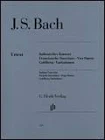Bach, Johann Sebastian : Ouverture(Partita) h-moll BWV 831
Work Overview
Publication Year:1735
First Publisher:Weigel
Instrumentation:Piano Solo
Genre:suite
Total Playing Time:30 min 30 sec
Copyright:Public Domain
Commentary (1)
Author : Asayama, Natsuko
Last Updated: June 1, 2007
[Open]
Author : Asayama, Natsuko
In Bach's Clavier-Übung II of 1735, he intended to juxtapose the two major styles: French and Italian. By this time, the differences between the two styles were often merely clichés, as they had in fact grown quite close. Bach, therefore, took even greater care to make the characteristics of both distinct. This is evident in the choice and arrangement of movements, and the form of the overture in the French Overture. The classical formula of keyboard suites (Allemande-Courante-Sarabande-(optional dances)-Gigue) was abandoned. The archaic Allemande was omitted, and the Overture is followed by a Courante. A Gavotte and Passepied are inserted between the Courante and Sarabande, and an Echo is placed after the Gigue. Such a free arrangement is also seen in Bach's own four Orchestral Suites, suggesting that this French Overture can be considered a transposition of the orchestral genre—rather than a keyboard suite—to the two-manual harpsichord. (The Italian Concerto, also included in Clavier-Übung II, is modeled after a concerto grosso. Incidentally, the fact that the Italian Concerto in F major and the French Overture in B minor are a tritone apart—a diminished fifth containing three whole tones, the most distant key relationship in the diatonic scale—also symbolizes the contrast between the two.)
The opening Overture follows the traditional slow-fast-slow form. The slow sections at both ends are exactly the same length, each 20 measures, with the characteristic dotted rhythm recurring. Considering that Bach abandoned the recapitulation of the slow section in the opening movement of Partita No. 4, which he also called "Ouverture," it suggests that here he is adhering more strictly to the form.
When performing French overtures, it is generally said that dotted quarter notes should be played longer, almost as double-dotted notes. Regarding this, David Schulenberg, who comprehensively discusses keyboard works in his The Keyboard Music of J. S. Bach (Japanese translation: Shogakukan, 2001), argues that this is an unnecessary debate based on a misunderstanding of tempo and articulation (Chapter 2, and the entry for the relevant work). Overtures are rarely marked with a slow tempo and are often notated in alla breve. That is, if an appropriate tempo is taken and clear articulation is applied before and after the dotted notes, there is no significant difference between playing dotted and double-dotted notes. Rather, attention should be paid to the tempo; if the overture is played unnecessarily slowly, it loses its vitality and becomes tedious.
Following the solemn Overture are dance movements, all small in scale and with clear rhythms. (An intention to clearly present the typical characteristics of each dance, rather than to further stylize them as in the Partitas, can be observed.) The Courante is a leisurely French-style movement in 3/2 time. Both the Gavotte and Passepied are paired in major and minor keys, with da capo indications. In the Echo placed after the Gigue, numerous "forte" and "piano" markings indicate changes in keyboard registration, and it is here that a movement finally appears that fully utilizes the characteristics of the two-manual keyboard.
Movements (8)
PTNA & Partner Channel Videos(24items) View More
Sheet Music
Scores List (8)

(株)春秋社

(株)全音楽譜出版社






















